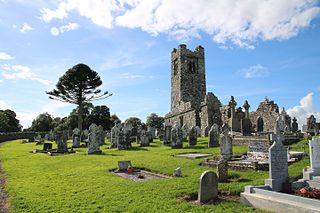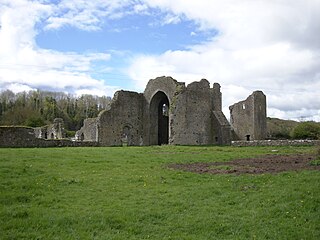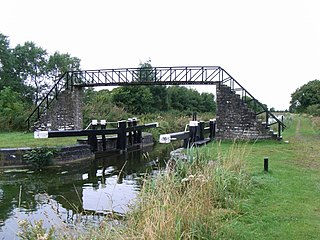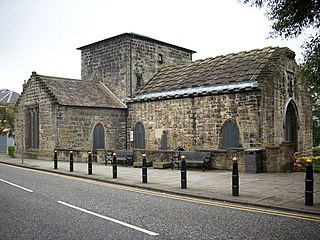
Slane is a village in County Meath, in Ireland. The village stands on a steep hillside on the left bank of the River Boyne at the intersection of the N2 and the N51. As of the 2016 census, Slane's population was 1,369. The village and surrounding area contains many historic sites dating back over 5,000 years. The village centre, as it is laid-out today, dates mainly from the 18th century.

Trim is a town in County Meath, Ireland. It is situated on the River Boyne and has a population of 9,194. The town is noted for Trim Castle – the largest Norman castle in Ireland. One of the two cathedrals of the United Dioceses of Meath and Kildare — St Patrick's cathedral — is located north of the river. Trim won the Irish Tidy Towns Competition in 1972, 1984, and 2014 and was the "joint" winner with Ballyconnell in 1974. Trim was historically the county town of Meath, but this title was passed on in 1898 to the larger, neighbouring town of Navan.

Trim Castle is a castle on the south bank of the River Boyne in Trim, County Meath, Ireland, with an area of 30,000 m2. Over a period of 30 years, it was built by Hugh de Lacy and his son Walter as the caput of the Lordship of Meath. The Irish Government currently own and are in charge of the care of the castle, through the state agency The Office of Public Works (OPW).

Ballybeg Priory, also known as Ballybeg Abbey, the Abbey of St Thomas, and St Thomas's Priory, is a 13th-century priory of the Augustinian order near the town of Buttevant, County Cork, Ireland. It is home to one of the best preserved and most substantial dovecots in Ireland. The priory was founded in 1229 and dissolved in 1541, the land and buildings passing into private hands. Those parts of the buildings that have escaped from the stone being removed for use in other buildings are mostly late medieval.

The Crutched Friars were a Roman Catholic religious order in England and Ireland. Their name is derived from a staff they carried with them surmounted by a crucifix. There were several orders devoted to the Holy Cross, collectively known as Crosiers, that had some presence in England and there is much confusion to which specific order the friars belonged. Earlier literature linked most of the Crutched Friars to the Italian Crosiers, but later it was proven that they were a branch of the Belgian Canons Regular of the Order of the Holy Cross. The Crutched Friars were suppressed during the Dissolution of the Monasteries in 1538.

Finchale Priory sometimes referred to as Finchale Abbey was a 13th-century Benedictine priory. The remains are sited by the River Wear, four miles from Durham, England. It is a Grade I listed building.

Bective Abbey is a Cistercian abbey on the River Boyne in Bective, County Meath, Ireland.

The Priory Church of St Mary and St Hardulph is the Church of England parish church of Breedon on the Hill, Leicestershire, England. The church has also been known as Breedon Priory and as the Holy Hill Monastery.

Longwood, historically called Moydervy, is a village in southwest County Meath, Ireland. It is located about 15 km south of the town of Trim on the R160 regional road. It is about 50 km from Dublin, off the N4 road. In the early years of the 21st century the population of Longwood increased dramatically, with the population more than trebling from 480 inhabitants as of the 2002 census, to 1,581 people as of the 2016 census. The 2016 census indicated that 65% of homes in the village were built between 2001 and 2010.

St Mary's Priory Church, Deerhurst, is the Church of England parish church of Deerhurst, Gloucestershire, England. Much of the church is Anglo-Saxon. It was built in the 8th century, when Deerhurst was part of the Anglo-Saxon kingdom of Mercia. It is contemporary with the Carolingian Renaissance on mainland Europe, which may have influenced it.
Events from the year 1539 in Ireland.

Tristernagh Abbey, also known as the Priory of Kilbixy or Tristernagh Priory, is a ruined Augustinian monastery in County Westmeath, Ireland. It is situated on the shores of Lough Iron, about 3 kilometres (1.9 mi) north east of the village of Ballynacargy.

St Chad's Church is an Anglican church in Poulton-le-Fylde, Lancashire, England. It is an active parish church in the Diocese of Blackburn and the archdeaconry of Lancaster. It is recorded in the National Heritage List for England as a designated Grade II* listed building. A church on the site was built no later than the 11th century and may have existed prior to the Norman conquest of England. The tower dates from the 17th century, and much of the remainder of the building from a major renovation in the 18th century, although some of the fabric of the original structure remains. Further renovation and additions took place in the 19th, 20th and 21st centuries.

Blackfriars Friary was a medieval Dominican friary dating back to the thirteenth century. The remains of the friary, located in Hereford, England, consist of monastery ruins, a cemetery, and a stone preaching cross. The ruins are surrounded by a rose garden established by the local community in 1964.

St. Mary's Abbey in Trim, County Meath, Ireland is a former house of Augustinian canons dedicated to the Blessed Virgin. The abbey was situated on the north bank of the River Boyne, opposite Trim Castle, on land given to St. Patrick who is often credited with founding the abbey. The abbey was a prominent pilgrimage site, famous for the healing power of its statue of the Virgin Mary, until its dissolution under Henry VIII during the Reformation. Little remains of the abbey except for the Yellow Steeple, the ruin of the abbey bell tower named for the yellow color reflected by the stonework in the setting sun, and Talbot's Castle, an abbey building converted to a manor house.

The Priory Church of St Mary of Mount Carmel, commonly called the Priory Church or St Mary's Episcopal Church, is a congregation of the Scottish Episcopal Church located in South Queensferry, near Edinburgh, Scotland.

Newtown Abbey is a medieval monastery and National Monument located in Trim, County Meath, Ireland.

Cannistown Church is a medieval church and National Monument in County Meath, Ireland.

The Priory of the Holy Cross, also called Rathfran Friary or Rathfran Priory, is a former Dominican Friary and National Monument located in County Mayo, Ireland.






















